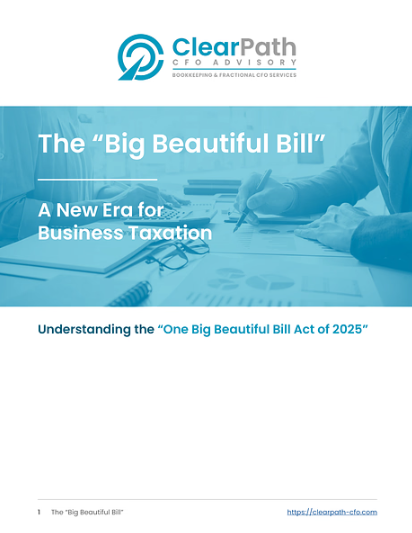
Blog

A New Era for Business Taxation
Understanding the “One Big Beautiful Bill Act of 2025”
The “One Big Beautiful Bill Act of 2025” was recently signed into law and introduces significant changes to the tax code for both individuals and businesses. This legislation aims to provide tax relief and stimulate economic activity. For business owners, understanding these changes is the first step toward strategic financial planning.
Full Expensing for Business Property (Sec. 168(k) – Bonus Depreciation)
This provision makes 100% first-year bonus depreciation permanent for qualified business property. It reverses the phase down that was scheduled under prior law, providing a significant and immediate tax saving opportunity for capital investments.
- Is it Sec. 179 or 168? This “full expensing” provision is an update to Section 168(k), commonly known as bonus depreciation.
- Unlike Section 179, bonus depreciation has no annual dollar limit and is not limited by your business’s net income.
- It applies to both new and used property that your business acquires.
- What it is: You can deduct the full purchase price of eligible assets in the year they are placed in service, rather than depreciating the cost over many years.
- Impact: This can dramatically reduce your taxable income and improve cash flow, freeing up capital to reinvest in your business.
Full Expensing of Domestic R&E Expenditures
The bill allows you to immediately deduct 100% of all domestic research and experimental (R&E) expenditures in the year they are paid or incurred.
- What it is: This reverses the recent requirement to capitalize and amortize these costs over five years. It applies explicitly to R&E conducted within the United States.
- Software Development Included: For this deduction, any amount paid or incurred in connection with the development of any software is treated as an R&E expenditure.
- Impact: This change strongly incentivizes U.S.-based innovation by providing an immediate tax benefit, which is especially helpful for startups and tech companies.
- Example Calculation:
▪ Scenario: A married couple filing jointly has a taxable income of $140,000 and QBI of $100,000 from their business. - Is their income below the threshold?
▪Yes, their $140,000 taxable income s below the new $150,000 threshold for joint filers. - Calculation: Because they are under the threshold, the calculation is simple: 20% of their QBI.
▪ Deduction: 20% x $100,000 = $20,000 QBI Deduction. - The deduction increases to 23% on January 1, 2026
Permanent & EnhancedQBI Deduction
The 20% deduction for Qualified Business Income (QBI) from pass-through entities (S corporations, partnerships, sole proprietorships) is now permanent and has been enhanced.
- Higher Income Thresholds: The taxable income limitation threshold, above which the deduction may be limited, has been increased to $150,000 for joint filers and $75,000 for other filers.
- New Minimum Deduction: For taxpayers with at least $1,000 in active QBI, the deduction is now the greater of the standard calculation or a minimum of $400.
- Increased 1099-NEC Reporting Threshold: The threshold for issuing a Form 1099-NEC for non-employee compensation has been increased from $600 to $2,000, and will be adjusted for inflation in the future.
Key Business Provisions (Part 2) – Credits & Reporting
Incentives and Reduced Compliance Burdens
- Enhanced Employer-Provided Child Care Credit:
- The credit rate is increased to 40% of qualified child care expenditures (50% for eligible small businesses).
- The maximum credit is increased to $500,000 ($600,000 for eligible small businesses).
- Repeal of the $600 1099-K Threshold: The rule requiring third-party settlement organizations to issue a Form 1099-K for transactions over $600 has been repealed. The law reverts to the previous de minimis exception of $20,000 and 200 transactions.
Impact on Individual Returns – Tax Relief for Families
How the Bill Affects You and Your Employees Personally
- Permanent Reduced Tax Rates: The reduced individual income tax rates from the 2017 Tax Cuts and Jobs Act are now extended and enhanced, making the lower rates permanent.
- Larger Standard Deduction:
▪ The increased standard deduction is made permanent.
▪ The bill provides an additional increase, raising the standard deduction to $15,750 for single filers and $31,500 for those married filing jointly for 2025. - Enhanced Child Tax Credit:
▪ The Child Tax Credit is increased to $2,200 per child.
▪ The credit is now permanent and will be adjusted for inflation.
▪ A Social Security Number is required for the child and at least one parent on the return to claim the credit. - Key Rules: The vehicle’s final assembly must occur within the United States, and it must be the taxpayer’s first use of the car.
- Income Phase-out: The deduction is reduced for taxpayers with a MAGI over $100,000 ($200,000 for joint filers)
Impact on Individual Returns – New Deductions
New Tax Breaks for Individuals (Effective through 2028)
These new “above-the-line” deductions can lower taxable income even if you don’t itemize.
No Tax on Tips
- What it is: A new deduction for qualified cash tips that are correctly reported.
- Deduction Limit: Up to $25,000 per year.
- Income Phase-out: The deduction is reduced for taxpayers with a Modified Adjusted Gross Income (MAGI) over $150,000 ($300,000 for joint filers)
No Tax on Overtime
- What it is: A new deduction for qualified overtime compensation required under the Fair Labor Standards Act.
- Deduction Limit: Up to $12,500 per year ($25,000 for joint filers).
- Income Phase-out: The deduction is reduced for taxpayers with a MAGI over $150,000 ($300,000 for joint filers).
No Tax on Car Loan Interest
- What it is: A temporary deduction for interest paid on a loan to purchase a new passenger vehicle for personal use.
- Improved Cash Flow: By reducing your tax burden, you free up cash for reinvestment, expansion, and day-to-day operations.
- Enhanced Financial Stability: Predictable tax obligations and improved cash flow lead to a more stable financial foundation.
- Informed Strategic Decisions: Tax planning impacts decisions around investments, hiring, and business structure.
- Compliance and Peace of Mind: A solid tax plan ensures you are meeting all your obligations and reduces the risk of audits and penalties
What Businesses Need from Tax Planning
Why Tax Planning is More Important Than Ever
With these new tax law changes, proactive tax planning is no longer a luxury—it’s a necessity for businesses that want to thrive.
What is Tax Planning?
It’s the legal and strategic process of arranging your financial affairs to minimize your tax liability. It’s about looking forward
and making informed decisions throughout the year, not just at tax time.
Who benefits?
Every business, from startups to established enterprises, can benefit from strategic tax planning
Key Benefits of Proactive Tax Planning
The Advantages of a Strategic Approach
- Reduced Tax Liability: Legally minimize the amount of taxes you pay by taking advantage of all available deductions and credits.4
- Maximize Business Deductions:
▪ QBI Deduction: Ensure your business is structured to take full advantage of the now-permanent and enhanced 20% QBI deduction.
▪ Retirement Plans: Maximize contributions to employer-sponsored retirement plans like a 401(k) or SEP IRA to reduce your taxable income.
Actionable Tax Planning Strategies for Your Business
Putting a Plan into Action
Here are some strategies to discuss with your financial advisor in light of the new law:
- Time Your Income and Expenses:
▪ Accelerate Deductions: With 100% full expensing reinstated, consider purchasing new equipment before year-end.
▪ Defer Income: If it makes sense for your business, you can defer billing to move income into the next tax year.
More Actionable Tax Planning Strategies
Leveraging the New Opportunities
- Utilize New and Enhanced Tax Credits:
▪ Child Care Credit: If you have employees with families, consider offering a child care assistance program to benefit from the enhanced credit. - Review Your Business Structure:
▪ The choice between an S Corp, C Corp, or LLC has significant tax implications. It’s a good time to review if your current structure is the most tax-efficient for your business. - Strategic Record-Keeping:
▪ Meticulous records are essential to substantiate all your deductions and credits, especially with the new expensing provisions for property and R&E.
